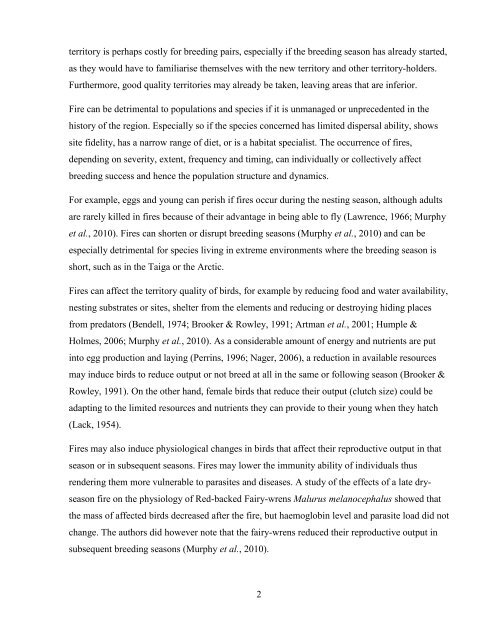Habitat use and population dynamics of the Azure-Winged Magpie ...
Habitat use and population dynamics of the Azure-Winged Magpie ...
Habitat use and population dynamics of the Azure-Winged Magpie ...
You also want an ePaper? Increase the reach of your titles
YUMPU automatically turns print PDFs into web optimized ePapers that Google loves.
territory is perhaps costly for breeding pairs, especially if <strong>the</strong> breeding season has already started,<br />
as <strong>the</strong>y would have to familiarise <strong>the</strong>mselves with <strong>the</strong> new territory <strong>and</strong> o<strong>the</strong>r territory-holders.<br />
Fur<strong>the</strong>rmore, good quality territories may already be taken, leaving areas that are inferior.<br />
Fire can be detrimental to <strong>population</strong>s <strong>and</strong> species if it is unmanaged or unprecedented in <strong>the</strong><br />
history <strong>of</strong> <strong>the</strong> region. Especially so if <strong>the</strong> species concerned has limited dispersal ability, shows<br />
site fidelity, has a narrow range <strong>of</strong> diet, or is a habitat specialist. The occurrence <strong>of</strong> fires,<br />
depending on severity, extent, frequency <strong>and</strong> timing, can individually or collectively affect<br />
breeding success <strong>and</strong> hence <strong>the</strong> <strong>population</strong> structure <strong>and</strong> <strong>dynamics</strong>.<br />
For example, eggs <strong>and</strong> young can perish if fires occur during <strong>the</strong> nesting season, although adults<br />
are rarely killed in fires beca<strong>use</strong> <strong>of</strong> <strong>the</strong>ir advantage in being able to fly (Lawrence, 1966; Murphy<br />
et al., 2010). Fires can shorten or disrupt breeding seasons (Murphy et al., 2010) <strong>and</strong> can be<br />
especially detrimental for species living in extreme environments where <strong>the</strong> breeding season is<br />
short, such as in <strong>the</strong> Taiga or <strong>the</strong> Arctic.<br />
Fires can affect <strong>the</strong> territory quality <strong>of</strong> birds, for example by reducing food <strong>and</strong> water availability,<br />
nesting substrates or sites, shelter from <strong>the</strong> elements <strong>and</strong> reducing or destroying hiding places<br />
from predators (Bendell, 1974; Brooker & Rowley, 1991; Artman et al., 2001; Humple &<br />
Holmes, 2006; Murphy et al., 2010). As a considerable amount <strong>of</strong> energy <strong>and</strong> nutrients are put<br />
into egg production <strong>and</strong> laying (Perrins, 1996; Nager, 2006), a reduction in available resources<br />
may induce birds to reduce output or not breed at all in <strong>the</strong> same or following season (Brooker &<br />
Rowley, 1991). On <strong>the</strong> o<strong>the</strong>r h<strong>and</strong>, female birds that reduce <strong>the</strong>ir output (clutch size) could be<br />
adapting to <strong>the</strong> limited resources <strong>and</strong> nutrients <strong>the</strong>y can provide to <strong>the</strong>ir young when <strong>the</strong>y hatch<br />
(Lack, 1954).<br />
Fires may also induce physiological changes in birds that affect <strong>the</strong>ir reproductive output in that<br />
season or in subsequent seasons. Fires may lower <strong>the</strong> immunity ability <strong>of</strong> individuals thus<br />
rendering <strong>the</strong>m more vulnerable to parasites <strong>and</strong> diseases. A study <strong>of</strong> <strong>the</strong> effects <strong>of</strong> a late dryseason<br />
fire on <strong>the</strong> physiology <strong>of</strong> Red-backed Fairy-wrens Malurus melanocephalus showed that<br />
<strong>the</strong> mass <strong>of</strong> affected birds decreased after <strong>the</strong> fire, but haemoglobin level <strong>and</strong> parasite load did not<br />
change. The authors did however note that <strong>the</strong> fairy-wrens reduced <strong>the</strong>ir reproductive output in<br />
subsequent breeding seasons (Murphy et al., 2010).<br />
2

















